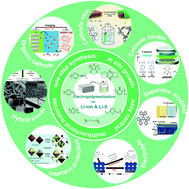Electrochemical construction of functional polymers and their application advances in lithium batteries
Abstract
Electrochemical methods are commonly used in the preparation of functional polymers on flexible conducting substrates to design and fabricate advanced electronic devices. The numerous merits of electrodeposited polymers including in situ growth of a free-standing bulk/framework, uniform deposition, well-designed porous structure, and abundant active sites have triggered the fast development of lithium batteries in recent years. Thus, the main focus of this review is the synthetic advantages and application progresses of electrochemically constructed polymer materials for lithium batteries. Firstly, the fundamentals of electropolymerization are introduced briefly. Secondly, the application progress of electropolymerized functional polymers in Li-ion and Li–S batteries is summarized according to their different functions, including active cathodes and hybrid anodes, coating layers, conductive hosts, separator modifier/functional interlayer and polymer electrolyte. Finally, some practical strategies and potential research directions are proposed. We expect that this review will provide novel design ideas to develop highly efficient polymer-containing lithium batteries.

- This article is part of the themed collection: Journal of Materials Chemistry C Emerging Investigators


 Please wait while we load your content...
Please wait while we load your content...